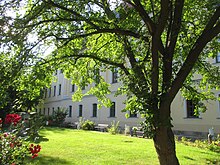Black mulberry
| Black mulberry | ||||||||||||
|---|---|---|---|---|---|---|---|---|---|---|---|---|

Illustration of black mulberry ( Morus nigra ) |
||||||||||||
| Systematics | ||||||||||||
|
||||||||||||
| Scientific name | ||||||||||||
| More nigra | ||||||||||||
| L. |
The black mulberry ( Morus nigra ) is a plant from the genus of mulberry ( Morus ) within the family of Mulberry family (Moraceae).
Occurrence
The black mulberry is originally native to western Asia . However, it was already planted in southern Europe around 1500 at the latest . It is now naturalized in the Mediterranean region and the southeastern USA . In contrast, it is rarely found in Central Europe , as it only thrives in the warmest locations. The largest documented collection of black mulberries in Central Europe (approx. 470 trees) can be found in the Pukanec vineyard in Slovakia .
description
The black mulberry grows as a deciduous tree and reaches heights of up to 12 meters. There are many bulbous thickenings and water shoots on the trunk . The bark is dark orange with many cracks that fray on its sides. The crown is low and broadly domed; old tribes are leaning or prostrate. The bark of the thick twigs is initially light green, later brown to purple-gray and somewhat hairy and has large scattered lenticels . The bud is thick and shiny dark purple-brown.
The leaves are divided into a petiole and a leaf blade. The hairy petiole is 1.5 to 2.5 cm long. The leaf blade is 8 to 12 cm long and wide, sometimes up to 18 cm ovate to heart-shaped with a pointed upper end. The leaf margin is irregularly notched and sometimes three-lobed. The leaf blade is rough and hairy, glossy dark green above, lighter below.
The male inflorescences are short, very light-colored catkins. The egg-shaped to spherical fruits are initially still green, turning orange to scarlet in July and dark red-red shortly before falling off. When fully ripe, they are sweet, juicy and edible.
The number of chromosomes is 2n = 26, 28, 30-308.
Taxonomy
It was first published in 1753 by Carl von Linné under the name Morus nigra in his work Species Plantarum , 2, p. 986.
use
There are several cultivated forms in culture. Here is a selection:
- 'Black Persian': With large black fruits that are about 3 cm long and almost as wide. The fruits are juicy.
- 'Chelsea': This shape bears long, dark fruits with a fine taste.
- 'Kaester': A high yielding variety that originated in Los Angeles. It makes large, elongated, black or dark red fruits. The fruits are about 3 to 4 cm long and almost 2 cm wide. The taste is very sweet.
- 'Wellington': A high-yielding variety with medium-sized, cylindrically elongated fruits. The fruits are about 3 cm long and 1 cm wide.
swell
- Alan Mitchell, translated and edited by Gerd Krüssmann: The forest and park trees of Europe: An identification book for dendrologists and nature lovers . Paul Parey, Hamburg and Berlin 1975, ISBN 3-490-05918-2 .
- California Rare Fruit Growers, Inc. datasheet (Description and Varieties Section)
Individual evidence
- ↑ Kristbergsson, K .; Ötles, S .: Functional Properties of Traditional Foods . Springer, 2016, ISBN 9781489976628 , p. 211.
- ^ Erich Oberdorfer : Plant-sociological excursion flora for Germany and neighboring areas . 8th edition. Verlag Eugen Ulmer, Stuttgart 2001, ISBN 3-8001-3131-5 . Page 320.
- ↑ Entry in GRIN - Taxonomy for Plants .
Web links
- More nigra at Plants For A Future
- Morus nigra L. In: Info Flora , the national data and information center for Swiss flora . Retrieved October 4, 2015.
- Thomas Meyer: Data sheet with identification key and photos at Flora-de: Flora von Deutschland (old name of the website: Flowers in Swabia )



